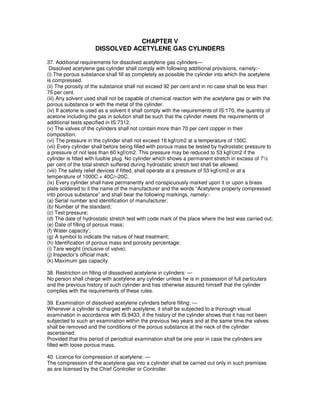Gas cyl rule5
- 1. CHAPTER V DISSOLVED ACETYLENE GAS CYLINDERS 37. Additional requirements for dissolved acetylene gas cylindersâ Dissolved acetylene gas cylinder shall comply with following additional provisions, namely:- (i) The porous substance shall fill as completely as possible the cylinder into which the acetylene is compressed. (ii) The porosity of the substance shall not exceed 92 per cent and in no case shall be less than 75 per cent. (iii) Any solvent used shall not be capable of chemical reaction with the acetylene gas or with the porous substance or with the metal of the cylinder. (iv) If acetone is used as a solvent it shall comply with the requirements of IS:170, the quantity of acetone including the gas in solution shall be such that the cylinder meets the requirements of additional tests specified in IS:7312. (v) The valves of the cylinders shall not contain more than 70 per cent copper in their composition. (vi) The pressure in the cylinder shall not exceed 16 kgf/cm2 at a temperature of 150C. (vii) Every cylinder shall before being filled with porous mass be tested by hydrostatic pressure to a pressure of not less than 60 kgf/cm2. This pressure may be reduced to 53 kgf/cm2 if the cylinder is fitted with fusible plug. No cylinder which shows a permanent stretch in excess of 7Â― per cent of the total stretch suffered during hydrostatic stretch test shall be allowed. (viii) The safety relief devices if fitted, shall operate at a pressure of 53 kgf/cm2 or at a temperature of 1000C + 40C/â20C. (ix) Every cylinder shall have permanently and conspicuously marked upon it or upon a brass plate soldered to it the name of the manufacturer and the words âAcetylene properly compressed into porous substanceâ and shall bear the following markings, namely:- (a) Serial number and identification of manufacturer; (b) Number of the standard; (c) Test pressure; (d) The date of hydrostatic stretch test with code mark of the place where the test was carried out; (e) Date of filling of porous mass; (f) Water capacityâ; (g) A symbol to indicate the nature of heat treatment; (h) Identification of porous mass and porosity percentage; (i) Tare weight (inclusive of valve); (j) Inspectorâs official mark; (k) Maximum gas capacity. 38. Restriction on filling of disssolved acetylene in cylinders: â No person shall charge with acetylene any cylinder unless he is in possession of full particulars and the previous history of such cylinder and has otherwise assured himself that the cylinder complies with the requirements of these rules. 39. Examination of dissolved acetylene cylinders before filling: â Whenever a cylinder is charged with acetylene, it shall be subjected to a thorough visual examination in accordance with IS:8433, if the history of the cylinder shows that it has not been subjected to such an examination within the previous two years and at the same time the valves shall be removed and the conditions of the porous substance at the neck of the cylinder ascertained: Provided that this period of periodical examination shall be one year in case the cylinders are filled with loose porous mass. 40. Licence for compression of acetylene: â The compression of the acetylene gas into a cylinder shall be carried out only in such premises as are licensed by the Chief Controller or Controller.
- 2. 41. Record of dissolved acetylene cylinders: â (1) Each firm charging acetylene in cylinders shall keep a record of every cylinder charged by it and this record shall give the following information, namely: - a) for each charge, (i) the date of charging of the cylinder, (ii) the empty cylinder weight without gas, (iii) the weight of solvent charged before gas charging, (iv) full weight of the cylinder; b) the dates upon which solvent has been added; c) the dates upon which the cylinder has been thoroughly examined as provided in Rule 39, the results of each such examination and the name of the person carrying out such examination, and in the case of cylinders first issued by the firm, the tare weight of the cylinder including porous substance and acetone or other solvent, the nature of the solvent and the maximum pressure allowed in the cylinder. (2) The record shall be open for inspection of the Chief Controller or the Controller of Explosives. 42. Labelling of dissolved acetylene cylinders. â A warning label attached to every dissolved acetylene cylinder shall, in addition to the particulars given in sub-rule (2) of Rule 9 bear the following additional particulars, namely: - (a) date of last filling of gas in the cylinder; (b) weight of gas filled; (c) full cylinder weight; (d) the name of the company filling the gas on the last date of the filling.


